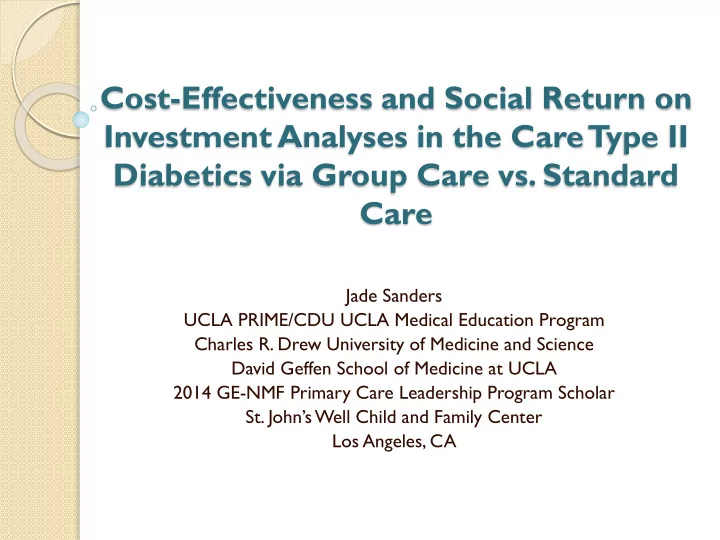

Cost-Effectiveness and Social Return on Investment Analyses in the Care Type II Diabetics via Group Care vs. Standard Care Jade Sanders UCLA PRIME/CDU UCLA Medical Education Program Charles R. Drew University of Medicine and Science David Geffen School of Medicine at UCLA 2014 GE-NMF Primary Care Leadership Program Scholar St. John’s Well Child and Family Center Los Angeles, CA
Introduction Population Statistics 29.1 million people have diabetes [1] 24.6 million are 45 and older [1] 2012 diabetes diagnoses in populations > 20 years and older [1] : ◦ 13.2% of Non-Hispanic blacks ◦ 12.8% of Hispanics ◦ 7.6% of the Non-Hispanic whites Cost Statistics Diabetes complications = strongest predictor of total costs [2] ◦ Cardiovascular Disease, Stroke, Retinopathy, Nephropathy, Neuropathy Estimated 2012 total diabetes cost: $245 billion [1] ◦ $176 billion - direct medical costs ◦ $69 billion - indirect costs
Background Group Care Model: St. John’s Williams Clinic Previous Research Weekly Class Has shown effectiveness in the management of diabetic patients ◦ Patient Check-In & Vitals Non-Intervention Group showed [3] : ◦ Diabetes Management Education ◦ lower mean age ◦ Diabetes Complications Education ◦ higher probability of medical specialty care ◦ Break/Meal Time use ◦ Exercise ◦ higher probability of comorbid heart disease ◦ higher mean HbA1c levels ◦ higher probability of having no HbA1c within the past year
Context of the Project Inclusion criteria: ◦ Ethnicity: Hispanic or Latino descent ◦ Income: Low-income ◦ Diagnosis: Type II Diabetes Goal: ◦ Home Clinic: St. John’s Williams Clinic ◦ Begin a longitudinal analysis on the Age: Adult aged 18+ group care diabetes class at Williams to determine the program’s Exclusion criteria: effectiveness in managing Type II ◦ No HbA1c lab value reading since Jan. 2014 Diabetes patients Results ◦ 55 attendees from 05/07/14-07/02/14 ◦ 15/55 did not have a HbA1c lab value on record since Jan. 2014 ◦ 40 patients included in longitudinal analysis
Methodology Utilized Data Extraction System (i2i Tracks) to Establish a Set of Matched-Controls Management Outcomes Utilized Group Care Class Records to Track Weekly Group Care Outcomes Weight, Blood Pressure, FBS/NFBS Utilized Electronic Medical Records to Track Standard Care Outcomes Weight, Blood Pressure, FBS/NFBS, HbA1c Diabetic Complications
Preliminary Results Control Group Treatment Group Demographics 40 40 # of Study Participants 32 females; 8 males 32 females; 8 males Females; Males 57 years old 57 years old Range: 39-79 Range: 38-77 Age HbA1c 19 patients 30 patients (15 females, 4 males) (23 females , 7 males) Most Recent HbA1c > 7 Blood Sugar Levels 25/34 (74%) 7/12 (58%) FBS > 130 12/28 (43%) 20/32 (62.5%) NFBS > 180 Types of Complications 8 Neuropathy 7 2 Nephropathy 4 1 Retinopathy 4 1 (Ulcer) Ulcer/Amputation 0 Number of Complications 12 0-1 Complications 15 > 2 Complications 0 3
Moving Forward & Recommendations Future Steps ◦ Continue to track the management outcomes in 2014 ◦ Begin tracking Referrals and Hospitalization Rates ◦ Determine Cost for: Uninsured Visits, Quarterly Labs, Preventive Screenings, Medication ◦ Determine social value of group care ◦ Conduct Analyses Cost-Effectiveness Social Return on Investment Project Recommendations ◦ Establish a set mechanism for ongoing data collection
Conclusions Despite small study size & short duration ◦ Data shows promising trends in: HbA1c values & NFBS Long-term evaluation of management outcomes can show more positive trends associated with group care Only after long-term evaluation can cost-effectiveness and social return of investment analysis have significant meaning for group care practices
Acknowledgements General Electric-National Medical Fellowships Primary Care Leadership Program St. John’s Well Child and Family Center Dr. Matthew Ho (Faculty Advisor) Dr. Beatrice Germain (Site Supervisor) Dr. Helen DuPlessis Jim Mangia Liz Meisler Ivy Marx Dr. Shom Dasgupta Dr. Rosa Rodriguez
References Centers for Disease Control and Prevention. National Diabetes Statistics 1. Report: Estimates of Diabetes and Its Burden in the United States, 2014 . Atlanta, GA: US Department of Health and Human Services; 2014. Zhang X, Gregg EW, Cheng YJ, et al. Diabetes mellitus and visual 2. impairment: national health and nutrition examination survey, 1999- 2004. Arch Ophthalmol 2008;126(10):1421 – 1427. Simon GE, KatonWJ, Lin EH, et al. Diabetes complications and 3. depression as predictors of health service costs. Gen Hosp Psychiatry. 2005;27(5):344-51.
Recommend
More recommend